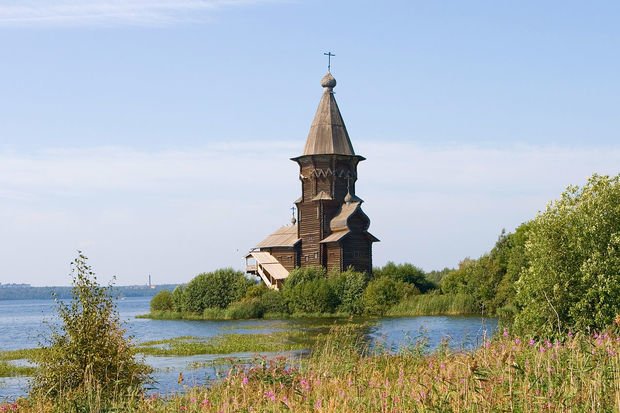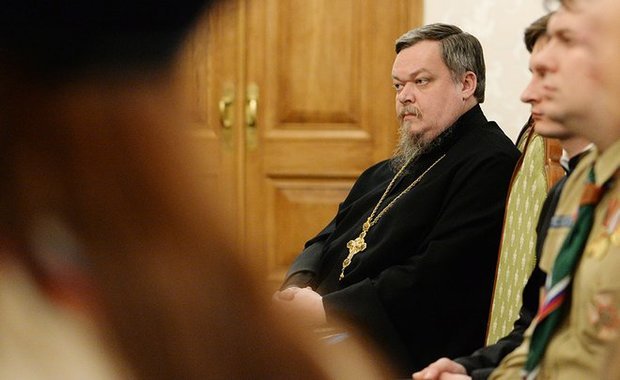Vsevolod Chaplin: ''The participation of the state in the 'public execution' would be perfectly correct''
Kondopoga: anti-religious extremism?
The arson of the Church of Dormition of the Mother of God in Kondopoga (Karelia) literally shocked the whole country. A unique site of Russian wooden architecture of the 18 th century has been destroyed. A 15-year-old teenager whom the media have already classified as Satanist is the suspect. Realnoe Vremya's columnist Archpriest Vsevolod Chaplin isn't indifferent to the fate of the old church. In a column written for our online newspaper, he tells how the church was left unattended and who is guilty of what happened.
Whose church?
The late masterpiece of wooden architecture – the Church of Dormition of the Mother of God in Kondopoga – unfortunately, was completely unprotected. And, unfortunately, the same thing can be said about many other churches ''protected by the state''.
Plenty of people have tried to loudly ask ''who is guilty'' and ''what to do'' in the last days. Answering the first question, representatives of the church and cultural establishment simultaneously blamed each other as well as federal power. The church had two owners, in fact – federal and church. Galina Brun, Karelian Minister of Culture and Mass Media, claimed as early as 2010 the building was registered as the propriety of the Russian Federation. And after the fatal fire no less famous official person – head of the territorial administration of the Federal Agency for State Property Management Valentina Troshiyeva – told the church was given to the Kondopoga parish of the Church of Nativity of the Blessed Virgin Mary in May 2017 according to an agreement on the right to use.
Such a scheme might seem strange to someone – the owner and the user are two different people. But it's very spread in case of holy buildings. And the reason is very simple: religious communities don't have either staff nor money to meet the obligations as an owner, which is the state. However, when a church or a mosque are given to use, authorities get rid of a lion's share of responsibility, in fact. And it turns out like in Kondopoga: a site of federal importance is protected by a guard only, and nobody else. Yes, different inspections are carried out on behalf of the state, but their arrival usually doesn't mean allocation of money even for restoration, not to mention protection…

''The Dormition church was very vulnerable. It's a wooden building that had neither a fence nor surveillance by the police nor fire retardant treatment, which, in experts' opinion, could have saved the church from accidental ignition. And this is the state of affairs in many churches, especially those located in the north of Moscow in sparsely populated places.'' Photo: Sergey Sverdlov / wikipedia.org
To attempt at an architectural site is to throw oneself in front of the car
The Dormition church was very vulnerable. It's a wooden building that had neither a fence nor surveillance by the police nor fire retardant treatment, which, in experts' opinion, could have saved the church from accidental ignition. And this is the state of affairs in many churches, especially those located in the north of Moscow in sparsely populated places. Whoever can do whatever. Moreover, even a night guard, who was in Kondopoga, is a rare thing in such cases. The neighbouring parish (the ancient wooden church was registered as part of this kind of parish) could afford to pay for night vigil only in some lucky cases. There is almost enough money to pay the staff of the main church. And, as a rule, we're talking about not a full salary but a small compensation for a volunteer's work. There won't be enough money in both the local and even the federal budget to protect all sites. It's impossible to appoint a policeman to every church and every mansion. And I'm very afraid it will be always so. And the words ''protected by the state'' on plates are rather a fiction that's not able to frighten a brazen intruder.
To the liberal intelligentsia's dismay, I will dare to presuppose that the only way to save holy buildings from vandals is to tighten punishment and its inevitability. There must be a simple thought at the back of a young man's mind through television, the Internet, blogs: to attempt at an architectural site is to throw oneself in front of the car. You will be severely injured, all your life will be ruined.
The current Article No. 243 of the Criminal Code presupposes quite a wide range of punishment – from the lowest fine and compulsory labour to 6 years of imprisonment. A minor who is suspected of arson of the Dormition church certainly won't go to prison, and he has nothing to blame him for. This is why he's boasting. It's strange he hasn't posted a selfie in front of the flaming church. And it means the punishment must be tightened. To impose the highest fine of 3 million from the arsonist's parents now, even if it means they and their son will move to a social flat.

''Most importantly, if the suspicion is confirmed, we should forever forget #theyarechildren and shame the minor arsonist in public so that he will never forget it.'' Photo: patriarchia.ru
Caution: anti-religious extremism
The Article 167 also has Clause 2 that describes deliberate destruction or damage to property, including motivated by hooliganism by setting the fire. This norm is applied to people from 14 to 16 years and presupposes for up to 5 years of imprisonment. Its application, in this case, is more than appropriate.
And, most importantly, if the suspicion is confirmed, we should forever forget #theyarechildren and shame the minor arsonist in public so that he will never forget it. Ordinary people can provide such a shame, but the participation of the state in the ''public execution'' would be perfectly correct.
There isn't so far any clear proof that the suspect was a satanist, moreover, he belonged to a group of devil worshippers. But if this is true, a separate investigation of all organisers and participants of the group is needed. It's where real extremism must be looked for – not among traditionally religious people and not among fans of accidental likes and reposts.
Anti-religious extremism, which justifies itself by satanism or atheism, is more and more widely spread in Russia and around the world today. It's no less dangerous than the pseudo-religious. In addition, it's not in Syria or Iraq but here, close, among ''honest'' laymen with indigenous ethnicity. And if it hasn't switched to large-scale violence and terror yet, this means weak popularity of this topic among ''YouTube heroes''. If there is no strictness and inevitability of punishment, be sure, it will be popular. And their spiritual ancestors quite succeeded here in the 20s and 30s.